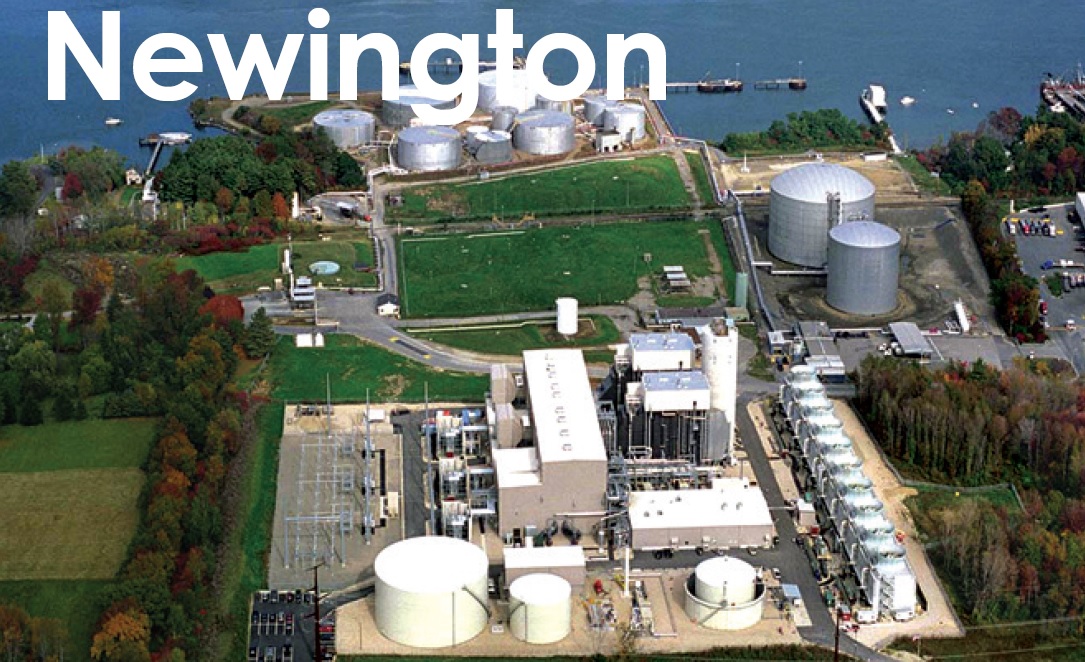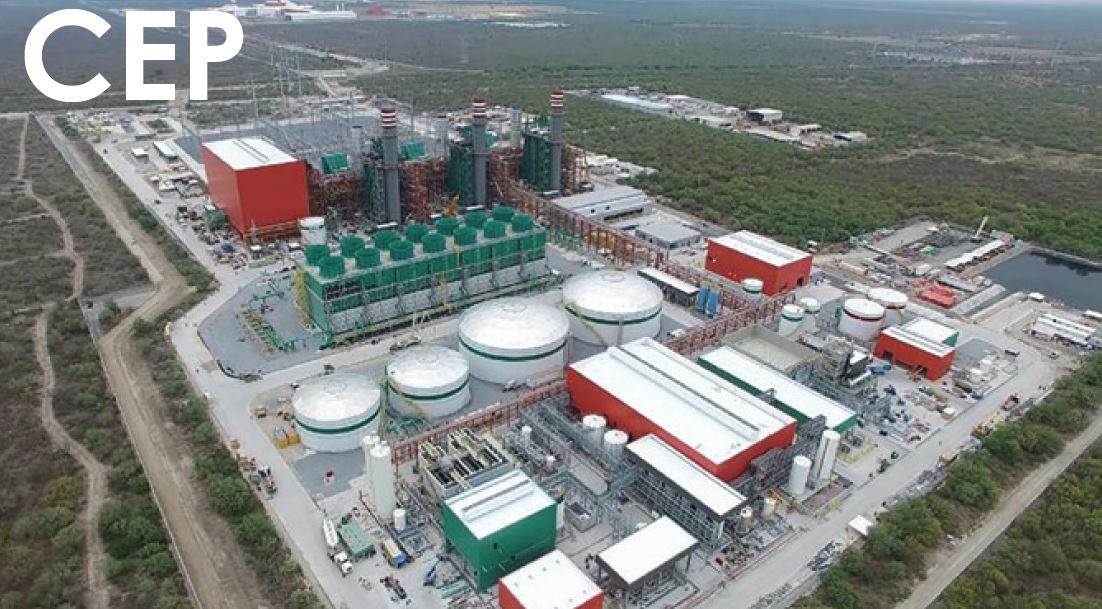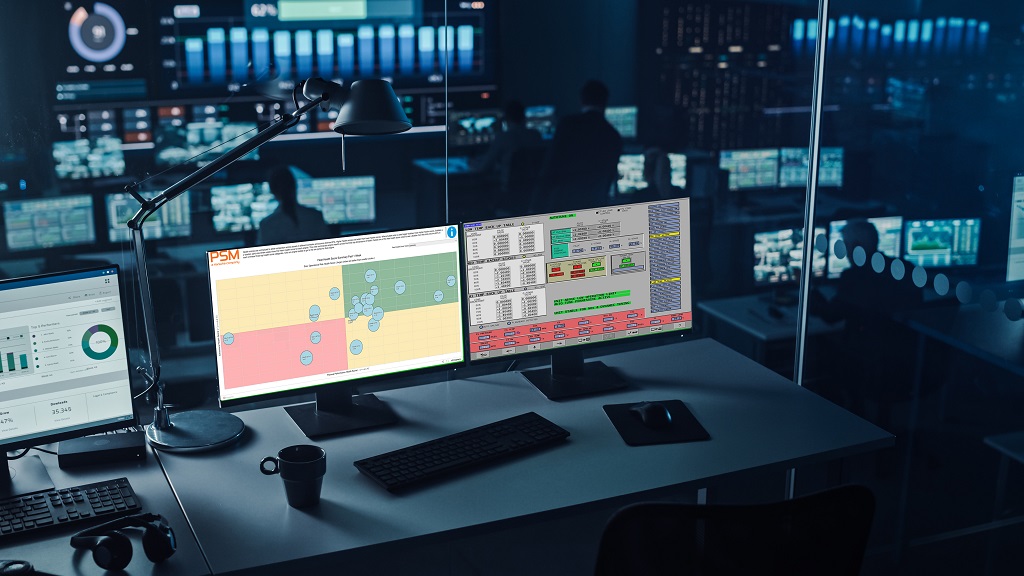
With relevant design and operational expertise, and applied data science, digital twins can be harnessed for areas such as fleet comparisons, plant-specific KPIs, and forward-looking predictions.
However, the twins are only as good as the domain expertise and data tools implemented to provide the analytics. PSM’s Greg Vogel, senior engineering manager for technology programs, will update attendees at the upcoming 7F Users Group conference (May 15-19, Atlanta) about how his company’s gas-turbine GT domain expertise has grown over the last 20 years.
Today, PSM’s design and validation methods and data sets, says Vogel, provide extensive learning opportunities for assessing data trends. By integrating this capability into a fleet of monitored GT assets, the company can tune its models both on a fleet and individual-unit basis.
Tuned digital twins allow operators to understand how a unit (or fleet) should be performing and highlight areas of lost potential as seen in the operational data. The web-based solution PSM is currently validating provides visualizations that start at a high-level health score and allow subsequent drill-down through analytical layers all the way to the individual twins.
Essential Power Newington
Owned by Essential Power Investments
Operated by Cogentrix Energy Power Management
565-MW, dual-fuel 2 × 1 combined cycle located in Newington, NH. Plant operated baseload from COD in 2002 until it began cycling in 2008
Plant manager: Tom Fallon
Electronic safety orientation program for contractors
Challenge. Essential Power Newington annually processes hundreds of contractors through its site-specific safety orientation program, consisting of an instructional safety-related video and certificate of completion. The rate of certifications increases significantly during outage periods.
The challenge of completing site safety and compliance training efficiently and effectively without impact to outage work schedules can be demanding. Beginning in early 2020, and continuing through 2021, Covid-19 concerns limited personal interaction and congregation in an effort to minimize risk of transmission. With contractors arriving from all areas of the country, the site explored digital and remote avenues which had not been invested in previously.
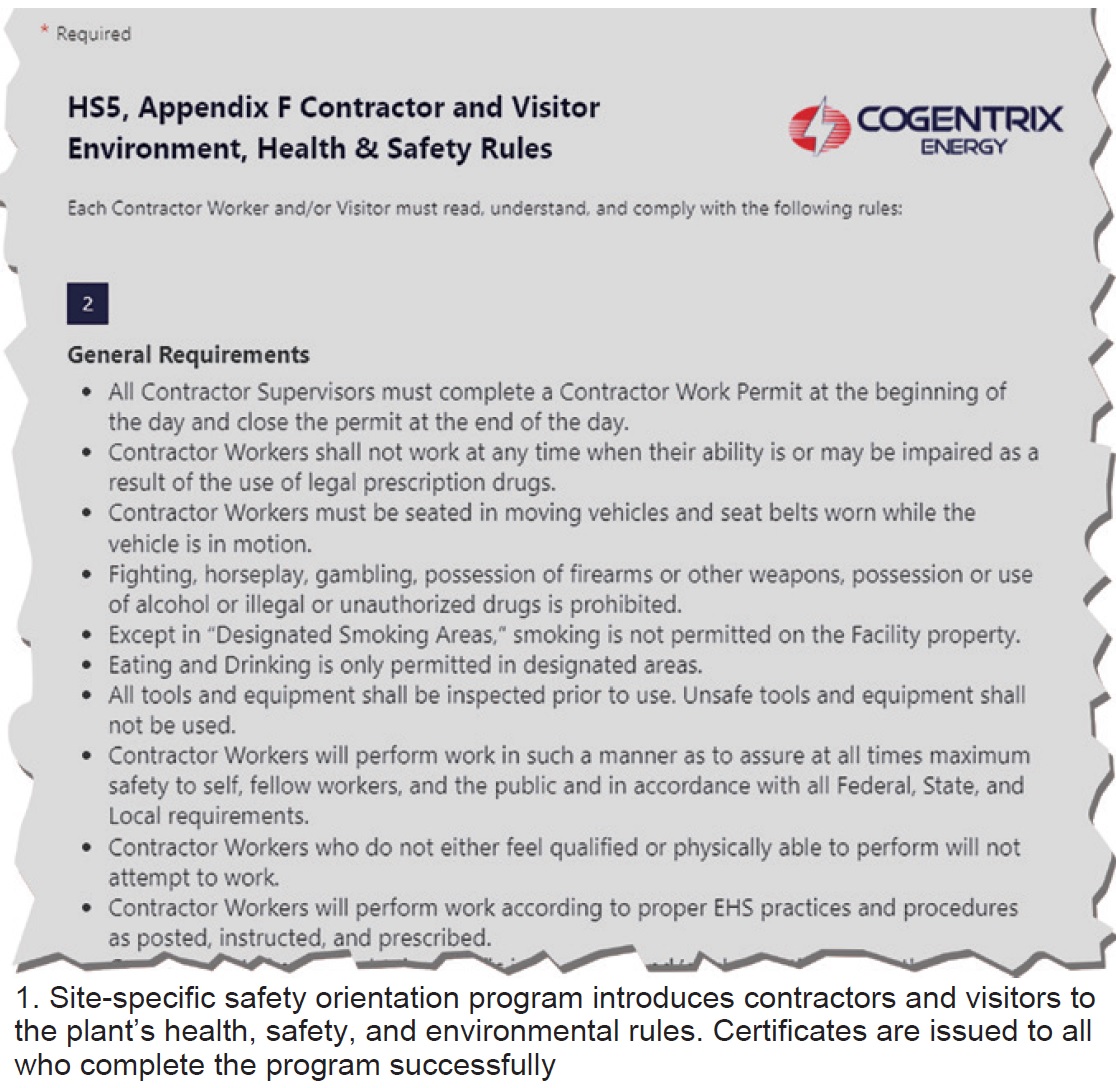
Solution. Staff explored various electronic resources to deliver its safety orientation video, facility EH&S rules (Fig 1), and NERC CIP compliance protocols to personnel arriving onsite. Critical quality features included the following: (1) ease of use for the end user and administrator, (2) ability to edit content as needed going forward, (3) compatibility with mobile phone use, and (4) ability to electronically verify completion.
Microsoft Office 365’s Forms program was the solution selected. It has the ability to e-mail contractors/vendors a message with an optional QR code and/or forms.office.com hyperlink.
Use of a mobile device and QR code allows quick navigation and orientation, and completion of required tasks. A hyperlink also is provided for PC use. Once the user receives the e-mail and accesses the form using either the QR code or link, he or she is able to review a customizable and site-specific embedded SharePoint link to the site’s 7-min orientation video (Fig 2).
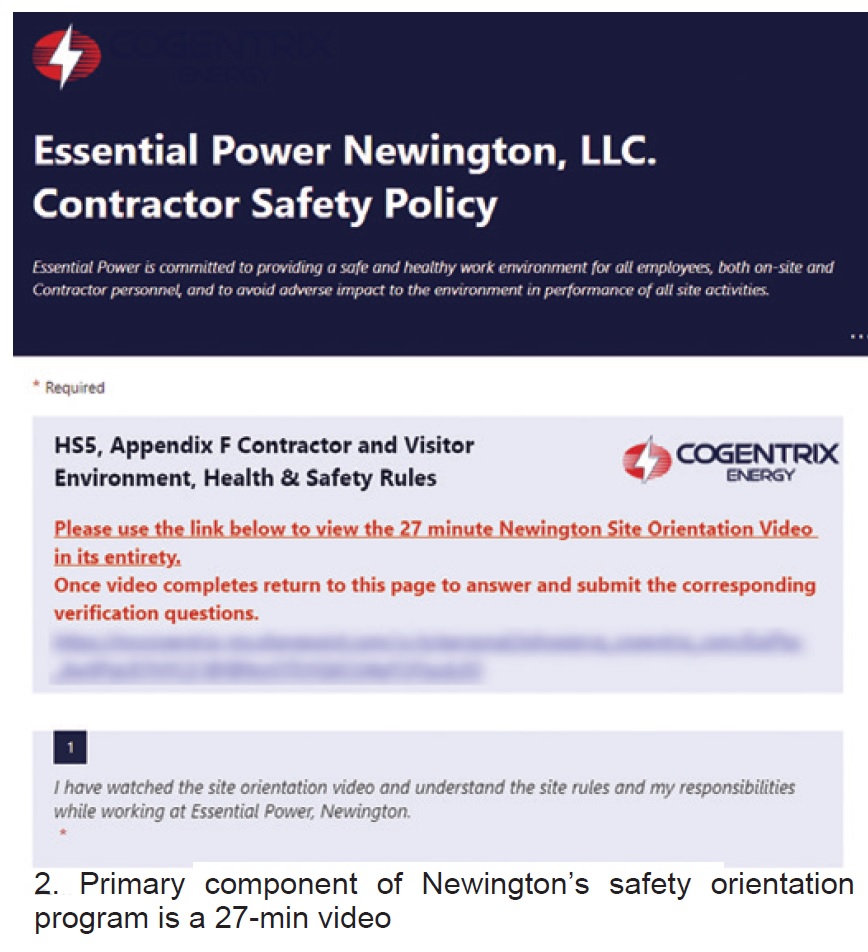
There also are several easily navigable electronic forms to review and verify completion.
Once the video has been watched and the form completed, the user initials the electronic form and submits it to the site’s EH&S manager. From there, data are compiled in a user-friendly electronic database for staff to review and to track the completion status of contractors. Electronic timing of form completion identifies potential attempts at subversion of the orientation process.
Results. The Office 365 Forms program has been tested by several employees and found effective and easy to use. Having the ability to watch the video and review and submit the electronic form from a mobile device provides contractors a user-friendly method for completing site orientation from outside the plant prior to arriving for the Newington outage.
Plus, electronic submission frees up significant paper resources and filing requirements.
Also, headcounts onsite in contractor orientation workspaces are reduced to those infrequent occurrences where electronic submission was not feasible ahead of time. When prequalified contractor personnel arrive onsite, they immediately report to the specified Point of Contact (POC) and receive their orientation-completion hardhat stickers.
The POC is able to quickly review orientation completion status in the electronic repository and directly answer any questions relevant to the training in the context of the contractor’s work scope.
In sum, investment in electronically facilitated site orientation saves resources and time and the efficiency of contractor safety- and compliance-training certification.
Project participant:
John Pierce
Upgrade to boiler-water sample panel helps ensure proper chemistry
Challenge. EPC engineers integrated a firetube boiler into the design Essential Power Newington for use during cold-plant startups to provide steam for turbine seals and HRSG sparging. The auxiliary steam system includes a deaerator supplied with cold demineralized-water makeup. Aux boiler use for HRSG sparging has increased as the plant moved from its original baseload operating profile to more of a seasonal peaking operation.
Sparging can be necessary for days at a time, or longer, depending on market dynamics and ambient temperature. Treatment chemicals are added via small electronic metering pumps. Chemical-pump stroke rates are adjusted manually based on grab-sample analysis in the water lab by an auxiliary plant operator. The original construction did not include any continuous analyzers to ensure proper control of boiler-water chemistry.
Solution. Site personnel reviewed water-chemistry key parameters for the low-pressure firetube boiler, selecting these three characteristics for continuous measurement: blowdown pH and conductivity, and feedwater dissolved oxygen. Staff then worked with a vendor to design a sample panel to measure the three variables using sampling equipment currently used onsite in the HRSG sampling system (Fig 3).
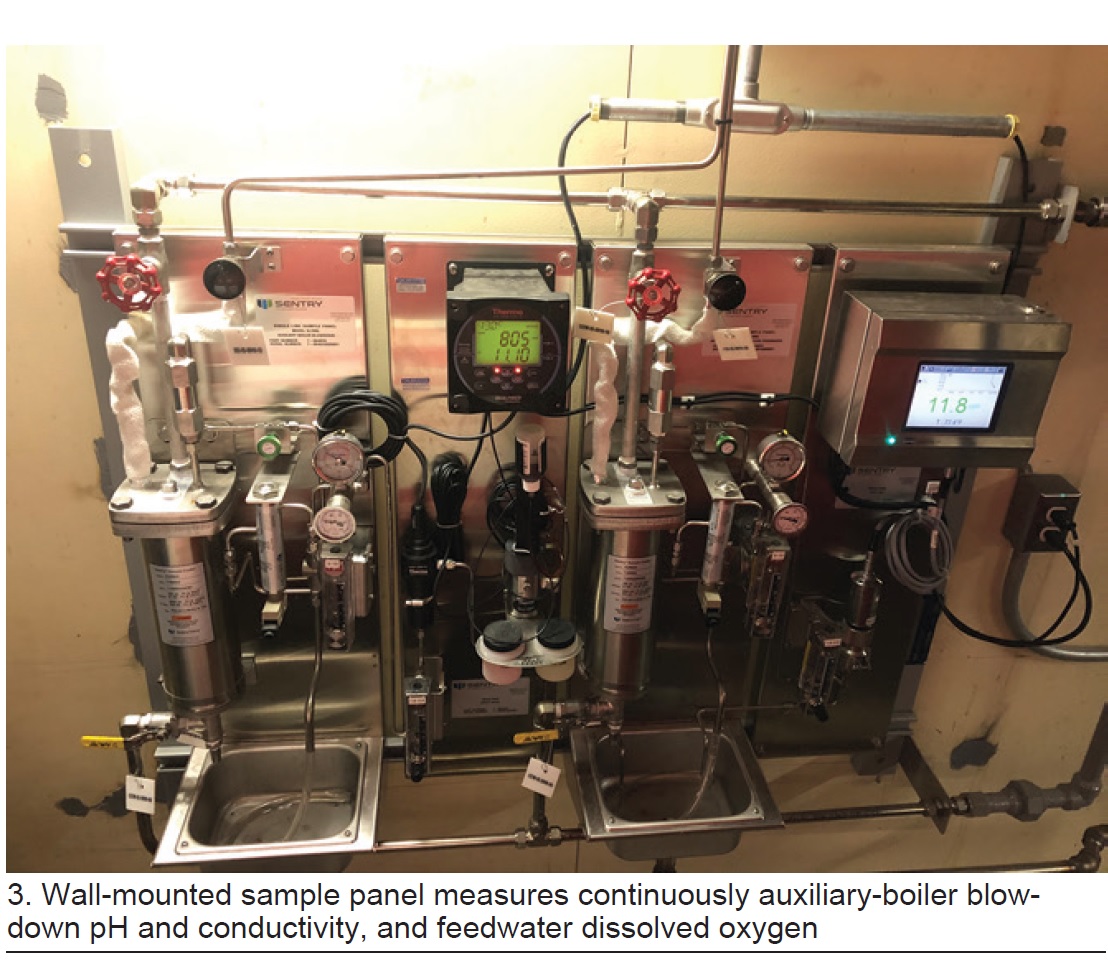
The final challenge for design of the sample panel was to find a location in the aux-boiler building where the panel would be close to the sample sources while also allowing O&M personnel proper access to other equipment. This involved minimizing the wall panel’s depth to maximize aisle space.
Results. Personnel completed installation of the sample panel during a recent plant outage. Analyzer outputs were wired to the DCS, where screen graphics were added and alarm triggers set. The analyzer outputs also were added to the PI historian for long-term trending and alerts.
While several additional continuous analyzers would be necessary to automatically control boiler chemistry, these three continuously measured characteristics help ensure proper chemistry maintenance between grab-sample analyses.
Project participants:
Kyle Malenfant, I&E technician
Michael Dill, I&E technician
Eric Pigman
Automating chemical injection key to tighter control of cooling-tower operation
Challenge. Because Newington was designed to operate baseload, it did not have an automatic scale-inhibitor injection system for the 1.5-million-gal saltwater cooling tower, which operates at 2.0 cycles of concentration and has a 150,000-gpm recirculation rate. A single salinity meter was installed on the circulating-water-pump discharge but there was no means for measuring makeup-water salinity continuously to accurately monitor for tower cycles.
The chemical treatment program for scale and dispersant control is an HEDP/polymer combination, which is injected into the tower basin. River-water makeup quality, 2.0 cycles of concentration, high surface temperatures in the condenser, and desired operating pH range were used to arrive at the optimal concentrations of treatment chemicals. A buffer is included to allow for routine fluctuations in makeup-water quality or upsets.
Given water-sample testing interferences with tower salinity, injection feed rates were based on blowdown flow rates, adjusted manually. This led to many occurrences of over- and under-injection because blowdown rates can fluctuate daily and seasonally.
Solution. Two new chemical-injection metering pumps were installed with microprocessor controls. The scale-inhibitor pump injection controls now run in automatic via a 4-20-amp control signal based on tower blowdown flow rate. In addition, a salinity meter was installed at the river makeup source to accurately monitor for tower cycles for tighter control.
These changes are conducive to a better tower chemistry program, one with both consistent scale protection and chemical control ranges. The makeup-water salinity instrument ensures consistent as-designed tower cycles, which, in effect, increases the concentration in the tower, and by automating the scale-inhibitor pumps, reduces chemical consumption. In sum, these changes reduce chemical costs and maintain a tighter tower-chemistry control program.
Results. With additional training on blowdown control rates and chemical injection operations, the control for combatting scale in the surface condenser is much tighter. Having accurate tower cycles, because of the added makeup salinity meter, allows staff to better regulate tower blowdown and injection feed rates to accurately manage the system during all operational profiles—while still offering opportunities for reductions in chemical consumption.
The scale-inhibitor automation improvement allows for less manual intervention when tower blowdown rates are fluctuating frequently based on plant operating profiles.
Project participants:
Joshua Leighton, Eric Pigman, and Scott Courtois
 Warning lights for overhead doors make plant safer for staff, visitors
Warning lights for overhead doors make plant safer for staff, visitors
Challenge. Large overhead roll-up doors are a concern in industrial workplaces—a recognized hazard that could cause serious physical injury or equipment damage if not acknowledged and controlled. Reasons include these: They are heavy, may fall closed while traveling if the head works fails, and may not be equipped to auto-reverse when they come in contact with an object or person.
Solution. Staff analyzed options for improving the safety and communications protocols for traversing through the plant’s large 20 × 20-ft turbine-hall overhead doors (Fig 4), commonly used by a large number of people. Visual indicators were deployed to provide additional warning and to remind personnel and visitors about overhead-door safety and site expectations.
Industrial LED light strips were a practical solution. The power and controls for them are incorporated easily into the operation of the door opener while providing warning lights by flashing RED when the door is in motion. Once the door reaches its fully open limit switch, the light strips turn solid GREEN (Fig 5). When the door moves closed, the LED strips again flash RED until the door fully closes against the pressure limit switch; the lights shut off after 30 seconds. The warning-light system is installed on both sides of the door frame, and both inside and outside.
In addition, large floor markings were developed to remind walking personnel to use the adjacent walk-through door for exiting and entering the turbine hall rather than an overhead door.
In conjunction with installation of the light strips on the door frame and conspicuous floor markings (Fig 6), the site instituted a standing directive that the doors not be driven or walked through while in motion. They can be traversed only when in the fully open position and the lights are solid GREEN.
Results. Use of visual stimuli to let staff and contractor personnel know a door is in motion, and communicating that you must not drive/walk through an overhead door in motion, has helped to prevent equipment damage and other safety events. While nothing is fail-safe, the addition of warning lights and floor markings remind about site protocols and the need to wait for the fully open status before moving through.
Project participants:
Mike Dill, I&E technician
Kyle Malenfant, I&E technician
Central Eléctrica Pesquería (CEP)
Owned and operated by Techgen
900-MW, 7FA.05-powered 3 × 1 combined cycle located in Pesquería, Nuevo León, Méxicó
Plant manager: Mario Alberto Ontiveros de la Torre
‘Improved’ brush holder offers safety benefits
Background. CEP’s four generators are equipped with the OEM’s EX2100e excitation system to control ac voltage at the generator terminals and/or reactive volt-amperes (VAr). Plant’s excitation system has a collector on the free side of the generator, where carbon brushes transfer the excitation current to the rotating slip rings and produce an electromagnetic field in the generator.
Incident. During normal monthly preventive maintenance, the following occurred when changing a brush on the negative pole: Technician inserted the brush holder, using its insulated handle (Fig 1), unaware that the carbon brush had slid out and been pushed to the middle space between the collector rings. The resulting electric arc damaged the rings and generator rotor.
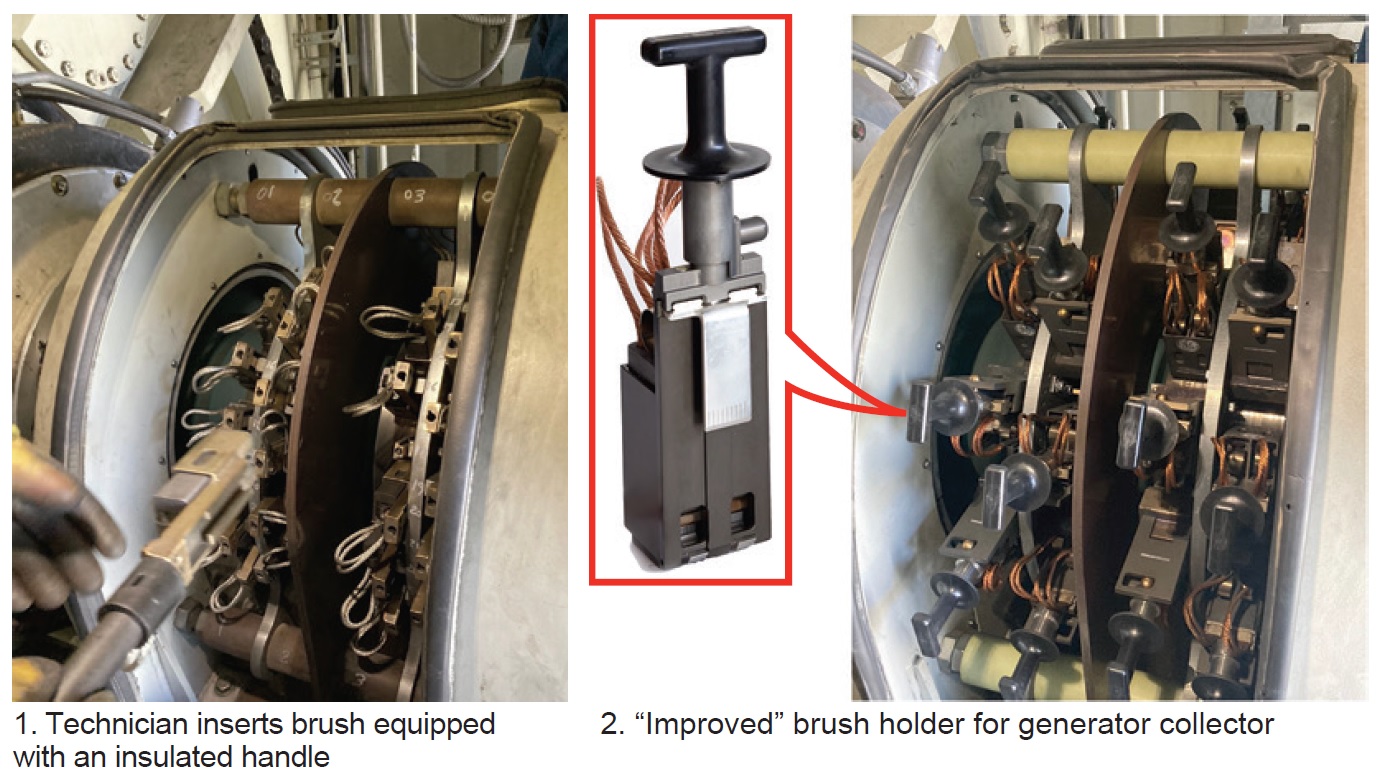
Solution. After the event, the maintenance and technical control team conducted a root cause analysis (RCA) and investigated collector-brush-system replacement options. GE’s “improved” brush holder (Fig 2) was selected for the following reasons: (1) Reduced the possibility of contact with live brushes, a significant safety benefit; (2) Provided higher reliability by eliminating incomplete insertions; and (3) Assured higher availability by reducing the risk of collector discharges.
Plus, brush wear can be seen easily through the inspection window, or by inspecting the wear indicator on the brush pigtail.
Results:
- Separation from energized components makes for a safer system, especially when changing out brushes with the turbine/generator in operation.
- Reduced risk of brush hang-ups.
- Tool-less maintenance given the permanently attached handle, which also reduces the time required for brush change-out.
- Reduced risk of collector flashovers.
- Increased brush size/life.
- Lightweight aluminum construction with a durable and anodized surface coating.
- Less susceptibility to brush-current selectivity (uneven current distribution between brushes).
- Direct replacement of single-wide holders without modification to the brush rigging.
Project participants:
Arturo González, technical control chief
Odon Acosta, maintenance chief
Arturo Macías, electrical coordinator
Copper braids outperform carbon brushes for shaft grounding
Challenge. Eliminate an unsafe condition present in the grounding-brush systems for CEP’s gas turbine/generators and implement an operating practice to enhance personnel safety and reduce the risk of equipment damage during routine maintenance.
The original grounding-brush system has a spring-type lock (Fig 3 left) that must be pulled and removed to release the brush for replacement or to perform maintenance, which sometimes must be done with the generator in operation (Fig 3 right).
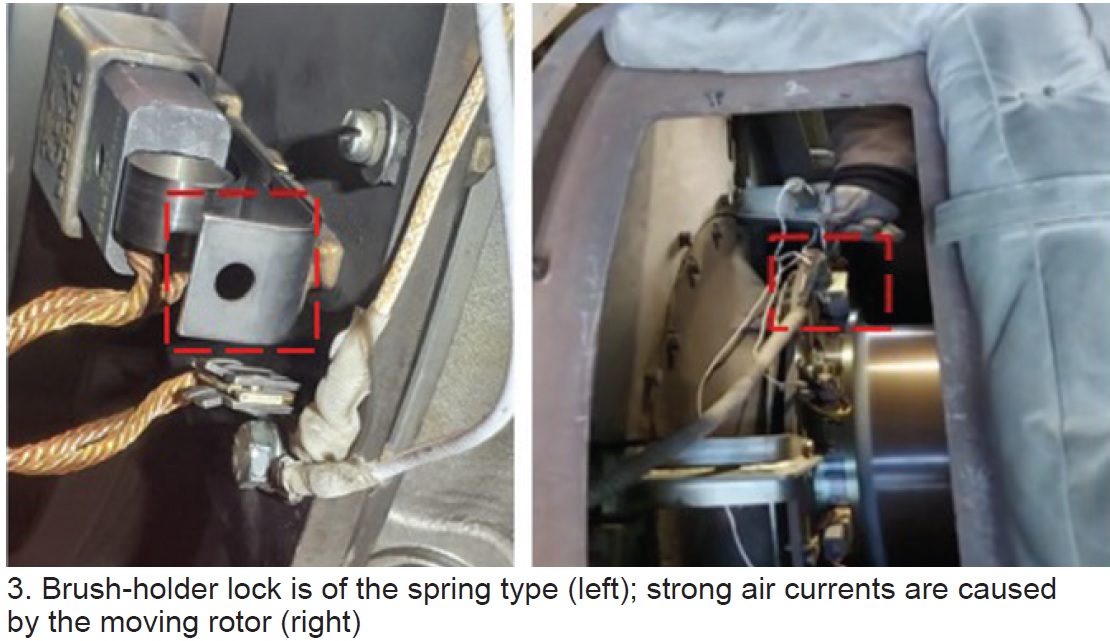
These factors are conducive to an unsafe condition because of the close distance between the operator and the working generator—a noisy environment with strong air currents.
Solution. After an exhaustive analysis by technical staff, an alternative grounding system was identified—one similar to that used in the steam turbine/generator. It uses copper braids that are extracted easily by pulling the fixing lever (Fig 4 left) and removing the braid to the side (Fig 4 right).
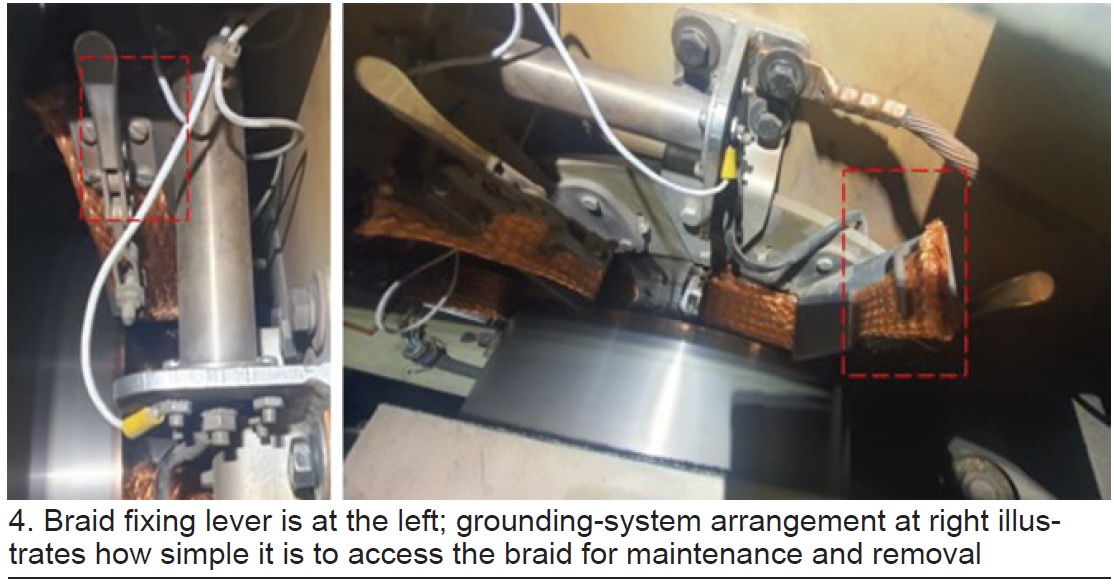
The new grounding system reduces the time required for maintenance: It is of simpler design than its predecessor and maintenance consists only of cleaning with dielectric solvent and verifying that the braid is not too worn (or replacing it if it is).
For insertion, the braid is placed on one side and pressed with the locking lever and it is ready for operation.
Results. The increased accessibility afforded by the new grounding system allows handling the components at a safer distance than previously—further away from the rotating machinery. Plus, the maintenance interval has been extended from one month to two, making the grounding system safer and easier to maintain.
Project participants:
Odon Acosta, maintenance chief
Arturo Macías, electrical coordinator
Plus, Isaí Real, Jorge González, and Jorge Rosalio
Replacement valve actuators provide ergonomic benefits, speed maintenance
Background. CEP has a ZLD (zero liquid discharge) gray-water treatment plant incorporating softening, ultrafiltration, reverse osmosis, and electrodeionization.
Throughput extends to nearly 6200 gpm.
Challenge 1. Reduce or eliminate failures of actuators for valves serving CEP’s five ultrafiltration modules. The original actuators were of a very robust design, each weighing about 200 lb. Thus, their removal for maintenance required cranes and the intervention of specialist personnel from different areas of the plant’s O&M team (Fig 5).
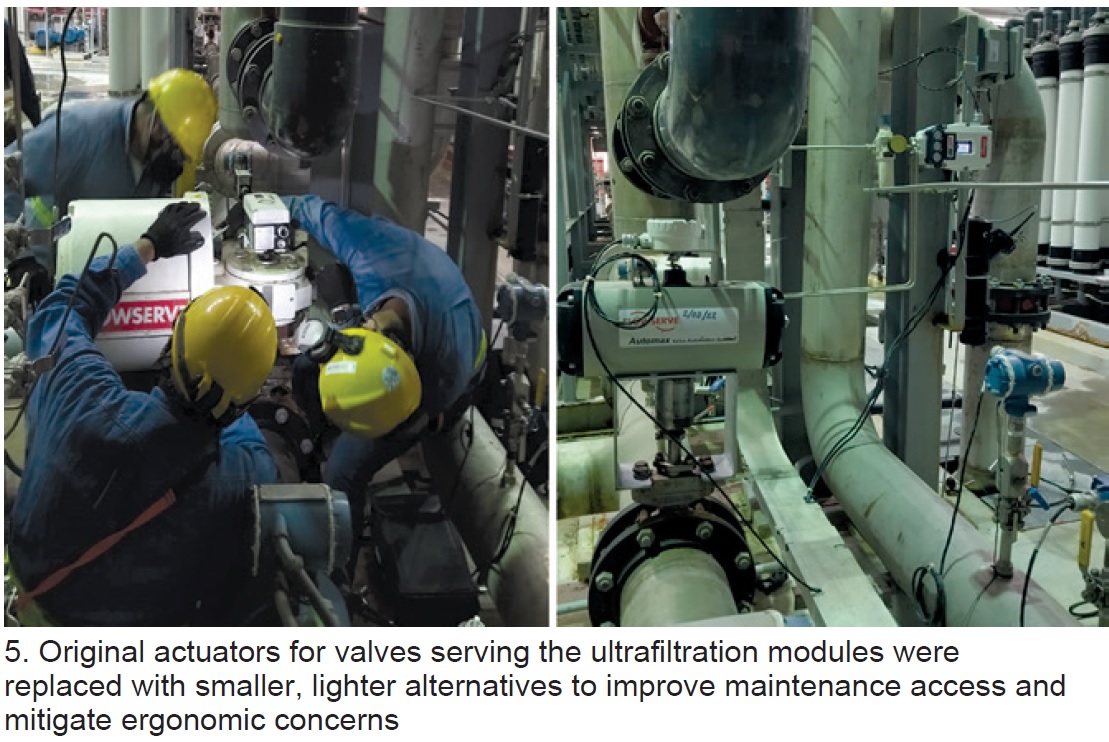
Regular actuator maintenance, typically required every six months because of wear and tear experienced by positioners, instruments, and other components primarily attributed to high vibrations, took about 16 hours. Actuator location complicated maintenance because of ergonomic concerns.
Solution 1 involved replacement of the original actuators with smaller, lighter ones (about 50 lb), thereby improving maintenance access to mitigate ergonomic concerns. Remote positioners were another improvement. Maintenance on the new actuators can be performed in-situ, eliminating the need for cranes and specialist personnel.
Results 1:
- Improved system availability.
- Time required for maintenance cut in half.
- Increased efficiency of maintenance personnel.
- Reduced costs of maintenance and spare parts.
- Less noise.
- Fewer module ruptures attributed to vibration.
- Ergonomic benefits included fewer accidents and fewer injuries to maintenance personnel.
Challenge 2. Increase the availability of the ZLD, which requires a heat exchanger to increase water temperature before it enters the crystallizer. This heat exchanger must be cleaned of scale deposits every two weeks using EDTA and nitric acid to maintain the level of performance required. Cleaning takes from 18 to 24 hours.
Solution 2. A second heat exchanger, independent of the original with all instrumentation required, was installed for use during cleaning turns and as a backup for the original.
Results 2. ZLD system availability and efficiency are assured.
Challenge 3. Eliminate or reduce recurring problems in the sludge-dewatering portion of the gray-water treatment plant. The two dewatered-product transfer pumps in the line to the cold-lime softening system suffered continual impeller damage and mechanical-seal wear, which caused pipes to plug and contributed to excessive maintenance.
Solution 3. The original multistage centrifugal pumps were replaced by single-stage units equipped with mechanical seals lubricated by service water to flush the seal cavity continuously, mitigating wear.
Results 3.
- Improved system reliability and availability.
- Eliminated corrective maintenance; only preventive maintenance is required today.
- Reduced the cost of maintenance and spare parts.
- No lubrication problems were associated with the seal flush system.
- Reduced the cost of system cleaning.
Project participants:
Odon Acosta, maintenance chief
Plus, Moises Arroyo, Daniel Mendoza, Rolando Goytortua, Alma Rivera, Jonathan Herrera, Marco Lopez, Alejandro Domínguez, Juan Carlos Facio, and Luis Melgarejo
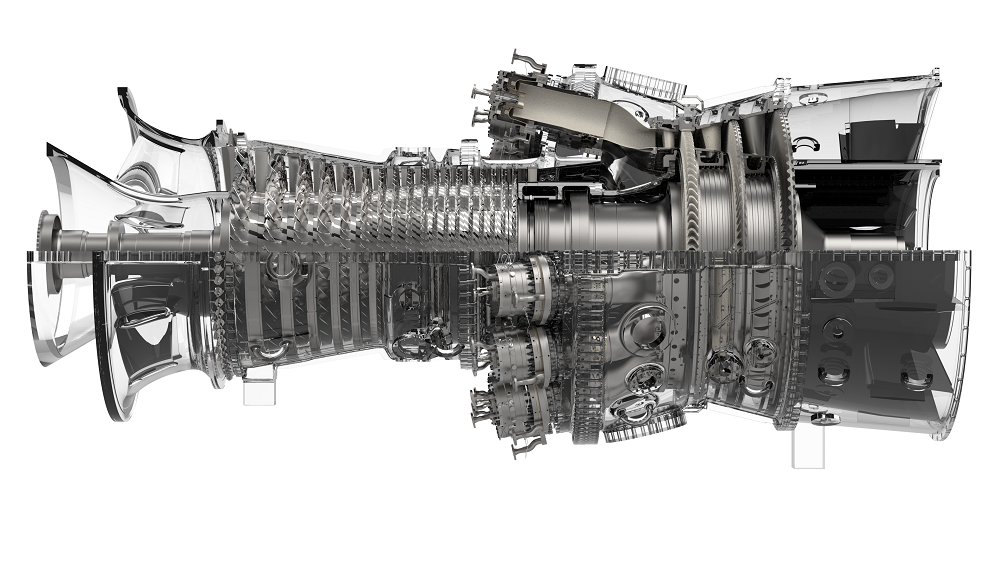
Planning to attend the 7F Users Group meeting at the Renaissance Atlanta Waverly, May 15-19? Registered? If not, sign up now and book your room.
That done, flag 11 a.m. Tuesday (May 16) in your electronic planner/reminder, when four platinum sponsors will begin their one-hour presentations on topics of importance to owner/operators.
If your work-related responsibilities focus on getting more from your gas turbines—more power, more operational flexibility, more time between overhauls, etc—consider attending the PSM session, “7F combustion and full engine solutions for a variety of energy-market applications.”
Greg Vogel, senior engineering manager for technology programs, and Bryan Kalb, combustion engineering manager, will cover two main topics:
- Combustion upgrades with FlameSheet™.
- GTOP development and performance upgrades.
If you have attended a gas-turbine meeting or read CCJ in the recent past, you probably have heard about FlameSheet™ and might think you can skip the PSM presentation. Not true. This preso is not a rehash of marketing materials. Rather, it focuses on the operational and fuel flexibility experiences achieved globally, up to the minute, by the innovative radially staged “combustor-within-a-combustor” (Sidebar) now installed or under contract in 27 units (mostly 7F), also including 501F, 7EA, and Fr5/1PA.
Design updates that further enhance the operational window of FlameSheet™ will be presented in detail, along with a road map covering the near- and long-term outlook of the 7F engine.
How FlameSheet™ works
PSM’s novel FlameSheet™ combustor relies on a simple, two-stage radially inflow “combustor-within-a-combustor” design concept that enables staged operation of each at various load conditions. Leveraging trapped vortex stabilization aerodynamics, the outer combustor operates with excellent stability, designers say.
This allows an increased operational zone, because the combustor can operate at much lower loads while maintaining stability and low CO, which generally restrict operation at low loads.
FlameSheet™ also is designed to handle a variety of fuels and fuel blends while keeping NOx and CO emissions low, without need for diluents or an SCR. This flexibility enables the combustor to satisfy industry needs with respect to the rapid onboarding of renewables as well as achieving decarbonization goals by mixing hydrogen with traditional fuels.
Fuel flexibility. Here are some of the highlights regarding fuel flexibility that will be covered:
- Current experience burning hydrogen blends and details of two major projects happening this spring.
- Details of E- and F-class combustion retrofit projects operating on hydrogen blends with PSM technology since 2018.
- Operational update on the first tri-fuel FlameSheet (natural gas, hydrogen-rich refinery off-gas, and back-up liquid fuel).
- Adaptation and installation of our FlameSheet™ platform to the Frame 7EA, including co-firing with hydrogen.
The operational flexibility portion of the presentation looks at the challenges posed by onboarding of renewables and shut down of traditional base load coal-fired assets. The speakers will explain how PSM can achieve turndown limits, within emissions compliance, under 30% in a 7F gas turbine with its latest generation of FlameSheet™ combustors.
Addition of the company’s GTOP package to FlameSheet™, 7F top-end performance can increase while remaining at low emissions limits for optimal peak performance. Actual installations and results will be presented.
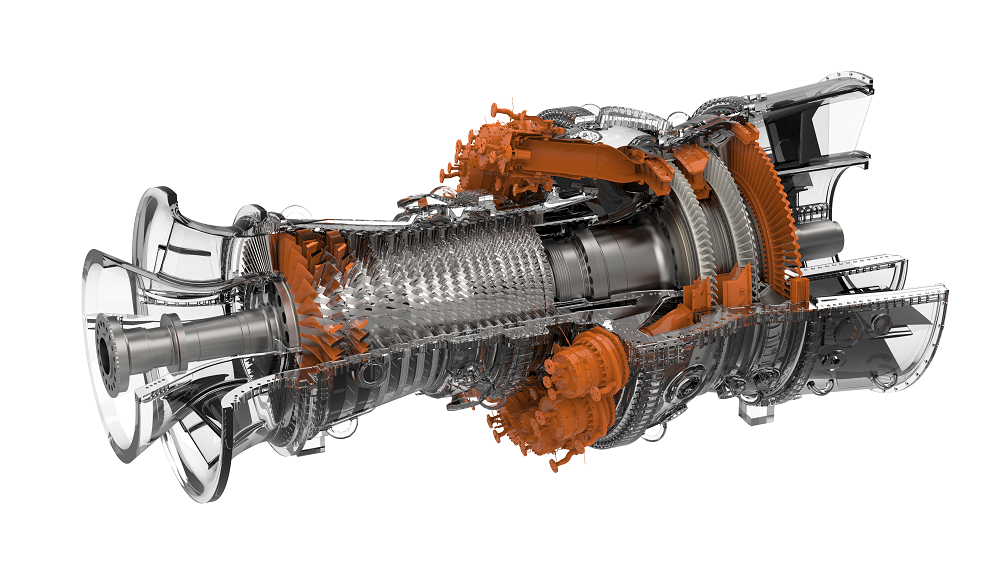
PSM’s 7F upgrade packages, which provide users the flexibility to optimize performance and maintenance schedules to their individual requirements, are covered in the second part of the session presented by Greg Vogel, senior engineering manager for technology programs, and Bryan Kalb, combustion engineering manager. Part one, outlined here, focuses on the company’s increasingly popular FlameSheet™ combustion system.
GTOP (Gas Turbine Optimization Package) supports three modes of operation—maintenance performance, and peak—and allows users to toggle among the three for optimal performance, depending on operational and business needs. Targeted hot-gas-path and compressor-part upgrades ensure a cost-efficient, reliable upgrade compatible with existing OEM 7F hardware. Remember, too, GTOP is compatible with multiple combustion systems—including FlameSheet™—to maximize the performance improvement.
Recall that GTOP 3.1 and 4.1 upgrades incorporate aerodynamically redesigned compressor parts—R0, S0, and S1—for increased compressor inlet flow and enhanced mechanical integrity. Recent installations and results will be reviewed by the speakers. Plus, the latest GTOP upgrades compatible with both 7F.03 and 7F.04 machines will be described.
New technology will be introduced as part of PSM’s GTOP4 program, which leverages the company’s experience gained in expanding its performance offerings to the 501F engine, promotes more cooling in the first stages of the turbine section. This suggests maintenance and life cycle costs with the PSM improvement may be more favorable compared to those experienced by users with the OEM’s AGP design.
PSM reminds readers of the typical performance improvements (below) recorded by installation of GTOP 3/3.1 on standard 7F.03 engines:
- Maintenance mode (32k), up to 6%
- Performance mode (24k), up to 8.8%
- Peak mode, up to 11.7%
Performance improvements possible with GTOP 4/4.1 will be presented at the 7F Users Group meeting—another reason to attend.
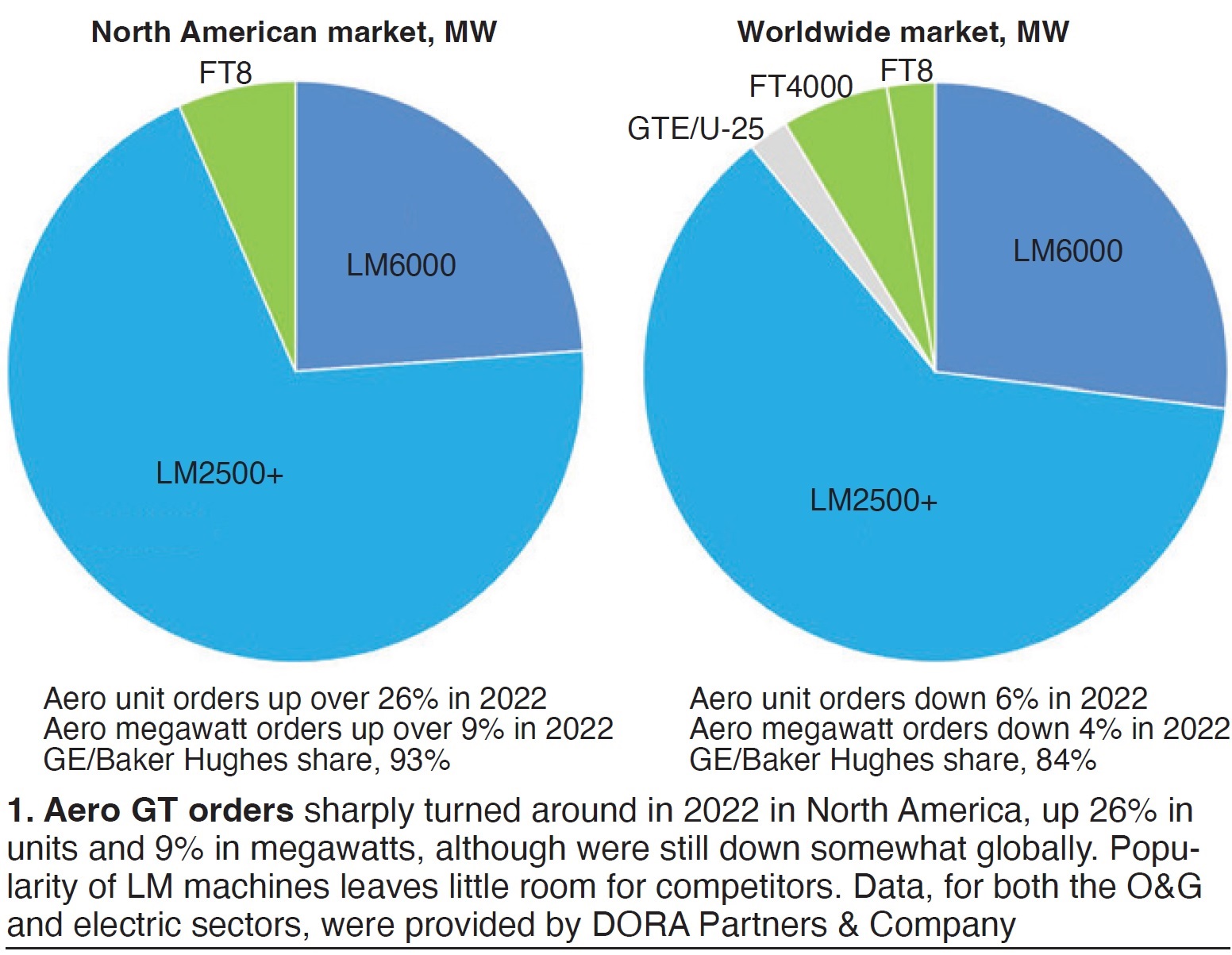 The war in Ukraine quite dramatically shifted the geopolitical energy scene in February 2022. In the US, the government has “declared war” on fossil fuels, yet backing alternatives with $340-billion under the guise of the oddly named Inflation Reduction Act (IRA). Even if “total activity in the aeroderivative gas turbine (GT) market has dropped off over the last 15 years,” the long-term prognosis for aeros is “pretty good.”
The war in Ukraine quite dramatically shifted the geopolitical energy scene in February 2022. In the US, the government has “declared war” on fossil fuels, yet backing alternatives with $340-billion under the guise of the oddly named Inflation Reduction Act (IRA). Even if “total activity in the aeroderivative gas turbine (GT) market has dropped off over the last 15 years,” the long-term prognosis for aeros is “pretty good.”
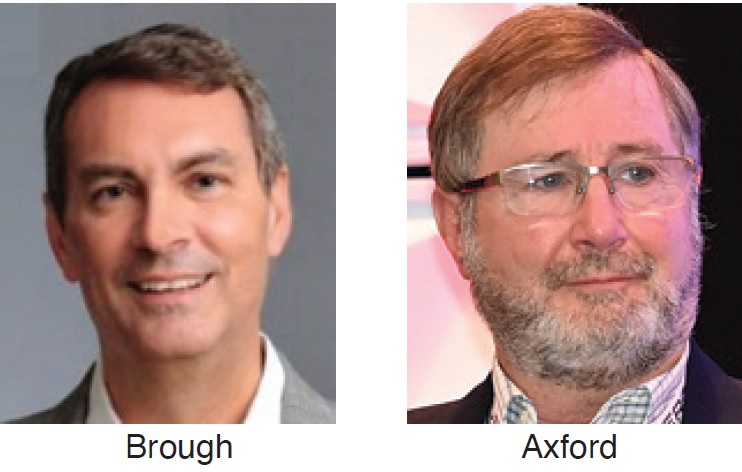 These were the salient conclusions of opening remarks given by Mark Axford, Axford Turbine Consultants LLC, and Tony Brough, Dora Partners & Company LLC, at Western Turbine Users Inc’s (WTUI) 32nd Annual Conference in San Diego, March 12-15, 2023.
These were the salient conclusions of opening remarks given by Mark Axford, Axford Turbine Consultants LLC, and Tony Brough, Dora Partners & Company LLC, at Western Turbine Users Inc’s (WTUI) 32nd Annual Conference in San Diego, March 12-15, 2023.
Brough opened by running through reams of statistics and graphs depicting the global gas turbine market. (Access to the Axford and Brough PowerPoints is limited to WTUI members and a few others. Request permission by writing Webmaster Wayne Feragen at wferagen@wtui.com.) Overall, GT orders (aeros plus frames) were up on a megawatt basis in 2022 but flat on number of units. Other Brough conclusions include the following:
- GE/Baker Hughes continues to strongly dominate the aero market (as Fig 1 reveals) with the new LM9000 machine having “long term potential.”
- Solar Turbines has introduced the Titan 350, aimed squarely at the LM2500+ market.
- Activity in hydrogen has heightened but “much needs to occur on the supply side to truly impact the gas turbine market.”
- Global expansion of LNG continues to rely on aeros as the critical driver.
- Solar PV is experiencing huge growth with 17 GW of utility-grade capacity added in 2022 and 30-40 GW scheduled to start up in 2023.
- LM turbine owners are seriously looking for alternative (as in unapproved by GE) service providers.
- Mobile, trailer mounted power generation, requiring “no forklift and no crane,” is a growing trend.
- There have been two consecutive years of improvement in the upstream (oil/gas) market for aeros.
If Brough was the straight man, Axford’s remarks were delivered with less data and more humor. He introduced himself by creating a new pronoun in an opening slide: “I identify as a turbine.”
The big headline from last year was that the huge Nord Stream Pipeline carrying natural gas from Russia to Europe (via Germany), and vital to European energy supply, was blown up. This act of sabotage shifted the global energy supply picture, while later events resulting from the war in Ukraine, such as sanctions on Russia, shifted them even more.
Axford invited his audience to ponder who was responsible for Nord Stream by showing a slide with a photo and quote from President Joe Biden, a photo and quote from US National Security Council Coordinator John Kirby, both sandwiching a photo and quote from Sergeant Schulz of Hogan’s Heroes, “I know noth…ing!”
Another aspect of the war on fossil fuels, said Axford, is that permits for offshore oil/gas drilling, which have to be renewed every five years, are being held up, as are permits for new drilling projects in Alaska. Axford then pressed the humor button again by playing the opening audio from “The Twilight Zone,” while showing a slide and narrating, “Imagine if you will. . .a world where people believe that the temperature of the planet can be controlled by giving more money to the government.”
Axford then borrowed a phrase, the “trilemma,” from Daniel Yergin, author and vice chairman of S&P Global, uttered at the recent CERA Global Energy Conference. It refers to the need to maintain security while providing energy sustainably and affordably.
This “energy transition,” which many experts call it, is not the first one the world has been through, Axford noted, referring to, for one, the century-long transition from wood to fossil fuels. However, it is the first, he believes, in which the old energy sources are being banned or discouraged by government intervention at the same time the new ones (solar, wind, and hydrogen primarily) are being developed by the market, albeit with generous government subsidies.
“It’s all too much too fast,” Axford suggested.
Regarding the GT supply chain, Axford focused on these developments:
- Siemens AG spun off Siemens Energy into a separate shareholder company, officially ended the Trent line of machines, and closed the remaining Dresser-Rand factories in the US.
- GE acquired Baker Hughes (BH) in 2016, but then restructured it beginning in 2018, divested it, and today BH trades on the Nasdaq. BH exclusively supplies GE’s turbines to the oil/gas sector.
- GE announced it is spinning off the gas, steam, and wind turbine businesses into a new separately listed company called Vernova; it is expected to be completed in early 2024.
- BH acquired the generator business of Brush Electric; Brush units are apparently a fan favorite of LM users.
- Mitsubishi is heads down on its large GT business; Axford wondered aloud if a spin-off of its aero division is in the offing.
Axford also spot-lighted two lesser-known names in the GT supply chain. Dynamis Power Solutions, which has been supplying DT35 mobile turbines for fracking applications and is a channel partner with BH. The company is now building the “no forklift, no crane” units for anyone who wants one. Relevant Power Solutions, also a channel partner of BH for TM2500 units, is building new trailer mounted LM2500+G4 gensets for lease or purchase. He also highlighted ProEnergy’s 81 LM6000 gensets in service or on order.
An interesting factoid from the offshore wind-turbine market segment of the talk is that blades are approaching 350 feet in length. Together with the tower height, total height is approaching that of the Empire State Building!
The three biggies in gas turbines—GE, Mitsubishi, and Siemens—also participate in the wind-turbine business, which Axford said “bled red ink” in 2022, and are facing “soaring materials costs,” shortage of rigs for installation, and “logistical nightmares” as machine size keeps growing. In the offshore wind market, the US is way behind China and Europe.
Chinese manufacturers dominate the wind-turbine market, capturing 70% of the global business in 2022. Note that the 95,000 MW bought from Chinese wind-turbine OEMs was nearly twice the worldwide gas-turbine order book last year (Fig 2).
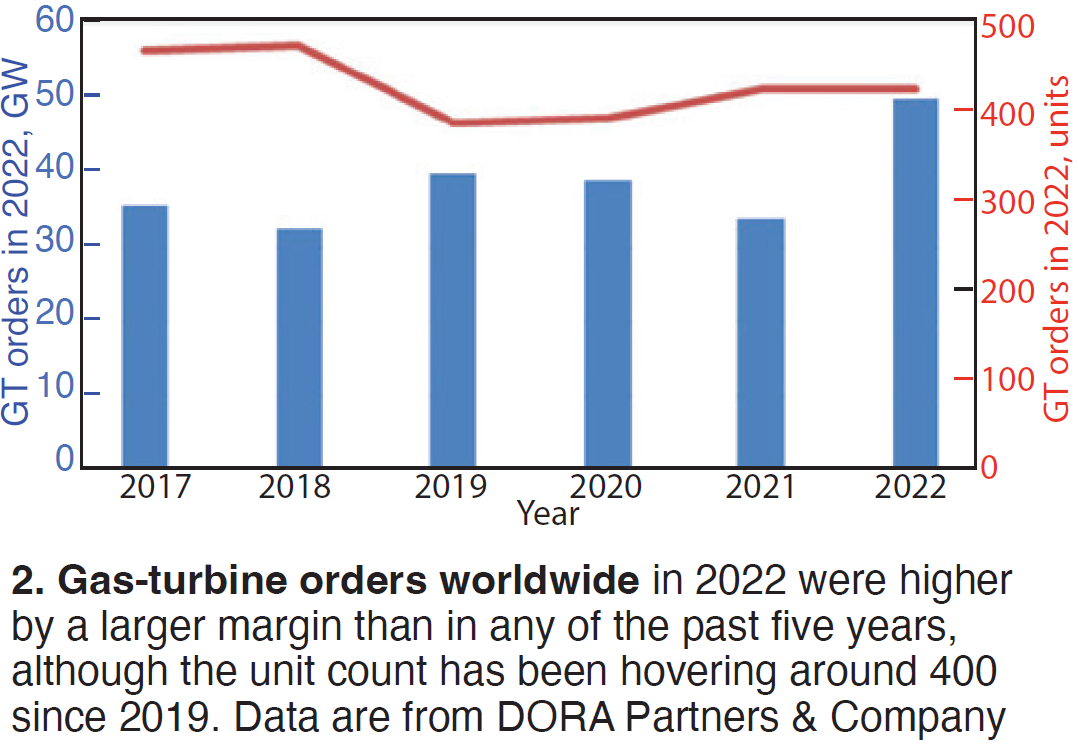
In the competition for GT business, Axford reminded his audience not to discount gas-engine gensets for peaking power and balancing services. Wartsila, for example, won over 500 MW of engine genset orders in 2022.
In his remarks on storage, batteries, and electric vehicles, Axford dispelled a myth out there that China has most of the world’s lithium deposits. In fact, Australia, Argentina, and Chile do. What China has is the lithium refining capacity.
In other comments, he noted that lithium ore costs had been steadily declining for at least five years, but in 2020, this reversed with a vengeance. Axford forecasted that lithium-based storage would never reach the goal set for automotive applications of $100/kWh. In 2022, lithium prices dropped by 30% but were still sixfold higher than the January 2021 figures.
The storage market “needs a lower-cost alternative to lithium,” Axford stressed. He apparently offered one by highlighting Form Energy and its iron-air battery (the process of rust formation and its reverse), Form’s $760-million factory being built in West Virginia, its 2 × 100 MWh demo sites in Colorado and Minnesota, and the investment of none other than Bill Gates.
In covering H2 activity, Axford predicted that in 20 years, the hydrogen market will be like the ethanol market and gasoline: blending with natural gas up to 15% on a volumetric basis, but not a big displacement of NG by H2 (15% H2 by volume equates to only 4.5% on an energy-input basis). Much of this will be driven by the generous subsidies for H2 in the IRA, but especially the “double dip” tax credit (assisting a whopping $10-billion of deal flow)—one for producing green H2 through electrolysis and one for displacing carbon-bearing material in an energy conversion process (Fig 3).
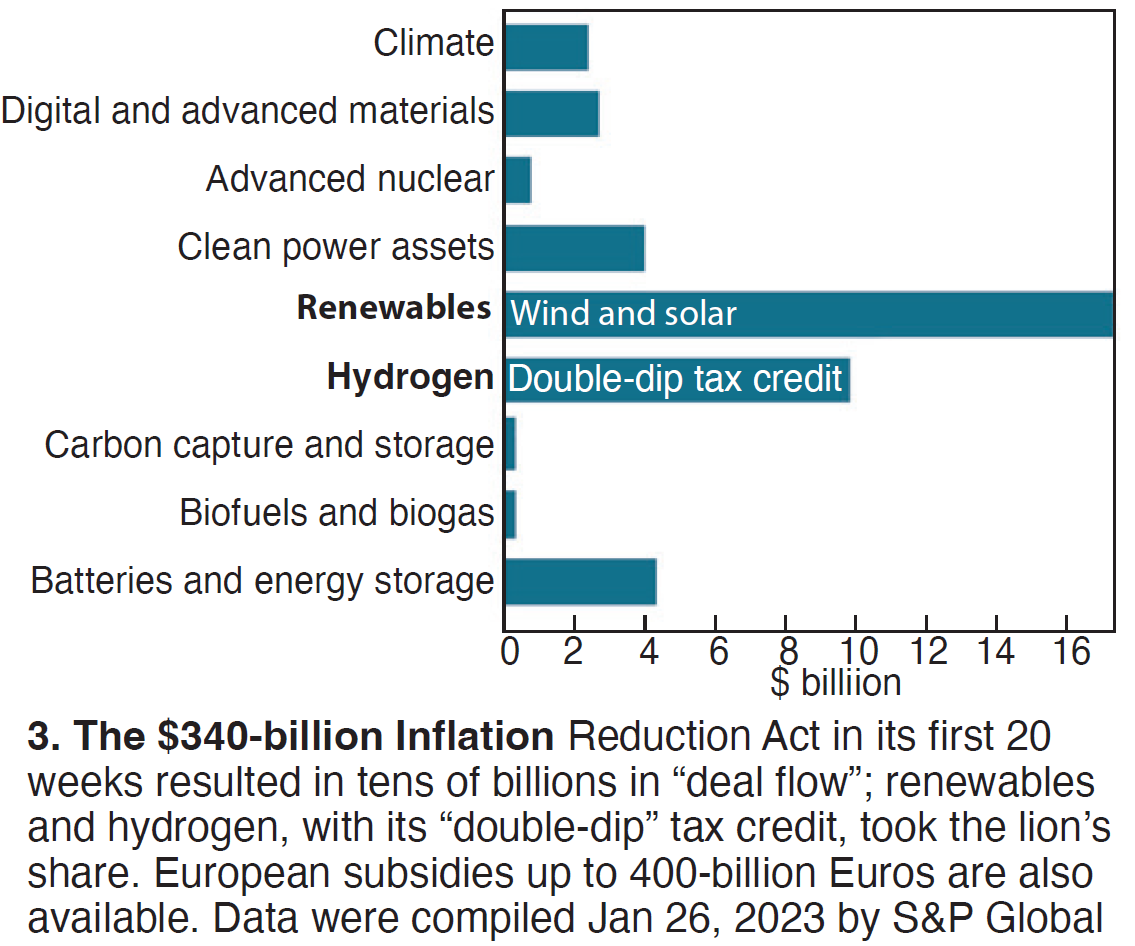
Leaving the best for last and keeping the attendees in their seats, Axford closed by forecasting that the GT market in 2023 will end down by about 20% compared to 2022. He added a few caveats, like all forecasters should, and invoked Yogi Berra’s quote, “the future ain’t what it used to be.”
The world’s largest user organization supporting owner/operators of 7F gas turbines promises a robust in-person conference and vendor fair when the group gathers at Atlanta’s Renaissance Waverly Hotel, May 15-19, for its 2023 meeting.
This year’s vibrant, reconfigured program assures a not-to-be-missed event. Vendor solutions highlight the mornings both Monday, May 15, and Tuesday, May 16, with traditional user-only general sessions in the afternoons, and vendor fairs from 4 to 7 p.m. Wednesday is dedicated to user-only general sessions in both the morning and afternoon. Thursday is GE Day. The Friday morning session has been expanded to include both the OEM’s traditional deep-dive knowledge-sharing program and two special user-only sessions of high value.
It’s important to register by COB Friday, April 14, to get the $445 early-bird conference fee, which increases to $495 on April 15, and to assure your accommodations are at the heavily discounted $189 daily group rate (plus tax, of course), which ends April 24, or earlier, if the room block sells out. An online reservation link will be provided to attendees after they register. You cannot arrange for a room at the conference rate any other way.
Stay tuned to www.powerusers.org for program updates as they become available, as well as other announcements.
More detail:
The vendor solutions presentations Monday and Tuesday morning are arranged in three 30-minute sessions with four services providers presenting simultaneously in each session. Four platinum-sponsor presentations, aggregated in a fourth 60-minute session, conclude the morning programs.
Monday, attendees can listen to half-hour presentations by GTC Control Solutions (a division of AP4 Group), HRST, Liburdi Turbine Services, PSM, CC Jensen, EthosEnergy, JASC, Turbine Generator Advisers, Riverhawk, and SVI Industrial; plus, hour presentations by AP4 Group, Arnold Group, ExxonMobil, and Shell Oil Products.
Tuesday’s half-hour presentations are by Allied Power Group, C C Jensen, National Electric Coil, Nord-Lock Group, Integrity Power Solutions, Lectrodryer, NRG Faist, Sulzer Turbo Services Houston, Carbon Reduction Systems, Marioff, and PSM; plus hour presentations by AGT Services, Industrial Air Flow Dynamics, MD&A, and PSM.
The general sessions Monday and Tuesday afternoon and all day Wednesday include a lineup of presentations and discussions by and among users on safety, combustion, auxiliaries, rotors, exhaust systems and components, and other topics yet to be finalized.
Vendor fairs Monday and Tuesday will showcase the products and services from five- to six-dozen companies each day. The generous three-hour exhibit hall program allows you to visit all the companies on your punch list while taking advantage of the heavy hors d’oeuvres and open bar.
GE Day topics were not available prior to publication. Based on programs from the last few years, presentations in the morning and breakout sessions in the afternoon likely will include safety; 7F fleet trends; outage planning and execution; GT systems reliability, controls basics, architecture, troubleshooting, and solutions; compressor/turbine/rotor; generator and electrical systems; parts and repairs; and combustion.
The Friday program has been greatly improved by the Steering Committee. It now offers a GE program and two user-only sessions. The GE program:
- Combustion turbine 401 is an advanced session for owner/operators focused on real-world examples.
- The forgotten upgrades, focusing on 7F conversions, modifications, and upgrades not recently highlighted.
- Customer Portal Issue Deep Dive offers opportunity for hands-on troubleshooting of issues with the Customer Portal.
The non-GE Friday sessions are the following:
- DLN tuning will discuss the hardware and software basics of DLN-2.6 (and differences of 2.6+) including input/output variables, control logic, emissions, dynamics, tuning techniques, and how to talk-the-talk with tuners.
- TIL review/tracking is an interactive presentation to share best practices and processes on how to efficiently and effectively track TILs from issuance to completion.
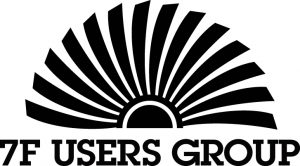 Compressor sessions at 7F annual meetings are well attended because of the depth of the presentations made and the follow-on Q&A and discussions they generate. A case history from the 2022 meeting helps refresh your recollection of how valuable the 7F content is and why you want to register for the Atlanta meeting NOW!
Compressor sessions at 7F annual meetings are well attended because of the depth of the presentations made and the follow-on Q&A and discussions they generate. A case history from the 2022 meeting helps refresh your recollection of how valuable the 7F content is and why you want to register for the Atlanta meeting NOW!
The user portion of last year’s conference leaped out of the gate on the first afternoon with a presentation on session on a most untimely failure of an unflared compressor rotor in a 20-year-old machine at a 2 × 1 site (DLN 2.6- and AGP-equipped) with 115,000 fired hours and over 1600 starts at time of failure. The S4 blade sheared off, and the R5 blade liberated. The machine trip was fully automated and orderly.
When the machine was opened up, R2 to R3 clashing was observed, and the liberated debris had collected around the turbine R1 nozzles. Analysis of the S4 blade revealed a 0.018-in. pit along with foreign deposits. Hypothesis on the failure mechanism was that a crack initiated at the S4 leading edge, then grew across the blade, and high-cycle fatigue excited the crack to liberation.
There was no evidence of vane lock but the OEM reported that as the root cause. In fact, the presenter conceded that a true root cause was “not really identified.” No evidence of vane lock was observed on the sister unit.
With hindsight, the presenter suggested that the owner/operator probably should have performed a full end-of-life (EOL) NDE on the compressor during the last outage. He said an average of 60% of the compressor blades were inspected then, but also that “a 0.018-in. pit is not easy to spot” during a routine outage inspection.
Of the options before them, the owner/operator elected to couple the original turbine rotor to a new unflared compressor rotor, which included the enhanced Package 5 upgrade (the failed unit had a Package 3), along with new R1 turbine nozzles. Total time offline: eight weeks.
Of greatest importance to the audience, or so it seemed, were the corrective actions taken to prevent a similar event on the sister unit:
- Increase offline compressor water washes to 3 times annually.
- Conduct the Package 3 upgrade (including the R0 stage) and consider replacing the carbon-steel stator rings for the 0-4 stages with stainless steel to reduce lock-up potential.
- Increase 100% borescope activities to twice annually.
- Inspect filter housing (with associated maintenance) twice annually.
- Ping test the R0 (using a third party, in this case EPRI) to check for lockup (the “only physical test available for lockup”).
- Use HEPA filters.
The presenter noted that the HEPAs made a “night-and-day difference after one summer run.”
The audience expressed much interest in the “smoke test” used at the site to detect housing leaks. It’s apparently common “for new installs” but a show of hands revealed that not many do it at operating sites. Presenter cautioned that “you need to find the right juice” to fuel the smoke generating machine.
Other details ferreted out during the Q&A included the following:
- The OEM states that a blade must be replaced if a “pit” is discovered but no action is required if only a “blemish.” This begs the question: What to do in the gray area in-between.
- Joints at the turbine bellmouth were not caulked and sealed properly after the outage.
- The site uses lake water for cooling. SO2 could be present from decomposing biomass.
- Online water washing is done every 48 hours; inlet filters are replaced every 2-4 years.
Imagine never having to change your oil again, not in your car, but in your combined cycle’s gas turbine (GT). Dr Matthew Hobbs, EPT Clean Oil, Calgary, Alberta, Canada, invites you to “rethink” how you treat your lube oil, first by focusing the treatment system on soluble varnish, and second, by adding ion charge bonding (ICB) ion exchange resins to continuously remove that soluble varnish.
In a webinar on March 9, “Eliminating varnish-related failures through lubricant chemistry management,” Hobbs asserted that use of ICBs essentially can avoid five to 10 oil change-outs over the life of a typical baseload GT, converting lube oil into an asset.
Doing so can save a bank vault’s worth of money (estimates available in the presentation), mostly by avoiding up to 24 hours of annual downtime attributed to poor lube-chemistry management. Varnish is responsible for more GT downtime than any other factor, claimed Hobbs.
Use of ICBs can also lower the carbon footprint of the machine. Hobbs stated that lubricant manufacturing is the most energy intensive sub-process in an oil refinery. If you put a value on that avoided carbon, the savings are even greater.
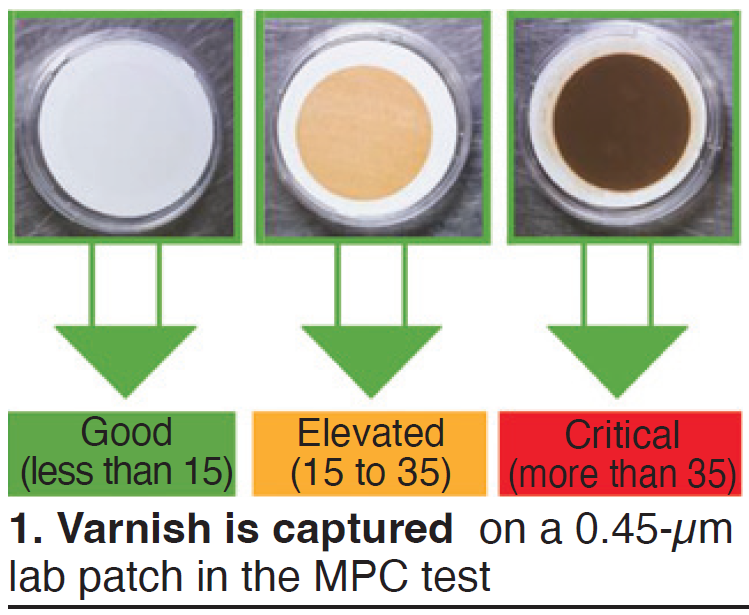 On the cost side, Hobbs, in responding to a separate communication following the webinar, reported that the cost of ownership of ICB would be around $6750/year (capital + consumables) over a 20-year life of a single 7F machine.
On the cost side, Hobbs, in responding to a separate communication following the webinar, reported that the cost of ownership of ICB would be around $6750/year (capital + consumables) over a 20-year life of a single 7F machine.
Most of Hobbs’ comments addressed deficiencies in current/typical lube-oil chemistry practice. “Today’s maintenance programs are as outdated as the pay phone,” he mused. Most of the deficiencies center on soluble varnish, tagged as the root cause of varnish issues, such as the following:
- End users tend to rely on third-party labs for testing, which often don’t test for varnish.
- Labs typically do not correctly run the all-important “membrane patch colorimetry” test (MPC, ASTM D7843): Samples must be heated for 24 hours and incubated for 72 hours to consistently detect soluble and insoluble varnish and establish an apples-to-apples comparison (Fig 1). Labs should report the hold times, in addition to the color intensity (ΔE) result.
- Cleaners/solubilizers change the form of varnish but don’t remove it; filters, while essential to remove other impurities, only remove insoluble varnish.
Engineered ICB ion exchange resins are thus the best option, according to Hobbs. Because oil-breakdown products are more attracted to the resin than to metallic component surfaces, these systems remove soluble varnish, which in turn reduces insoluble varnish, in a “positive feedback loop.” The amount of soluble varnish in the oil is dependent on operating temperature. Constant recirculation through ICB resins keeps the oil below the varnish saturation state.
The presentation, available at https://www.ccj-online.com/ept-webinar/, includes some dramatic video of varnish saturation changes with temperature and photos of MBC tests as well as varnished and unvarnished components (Fig 2).
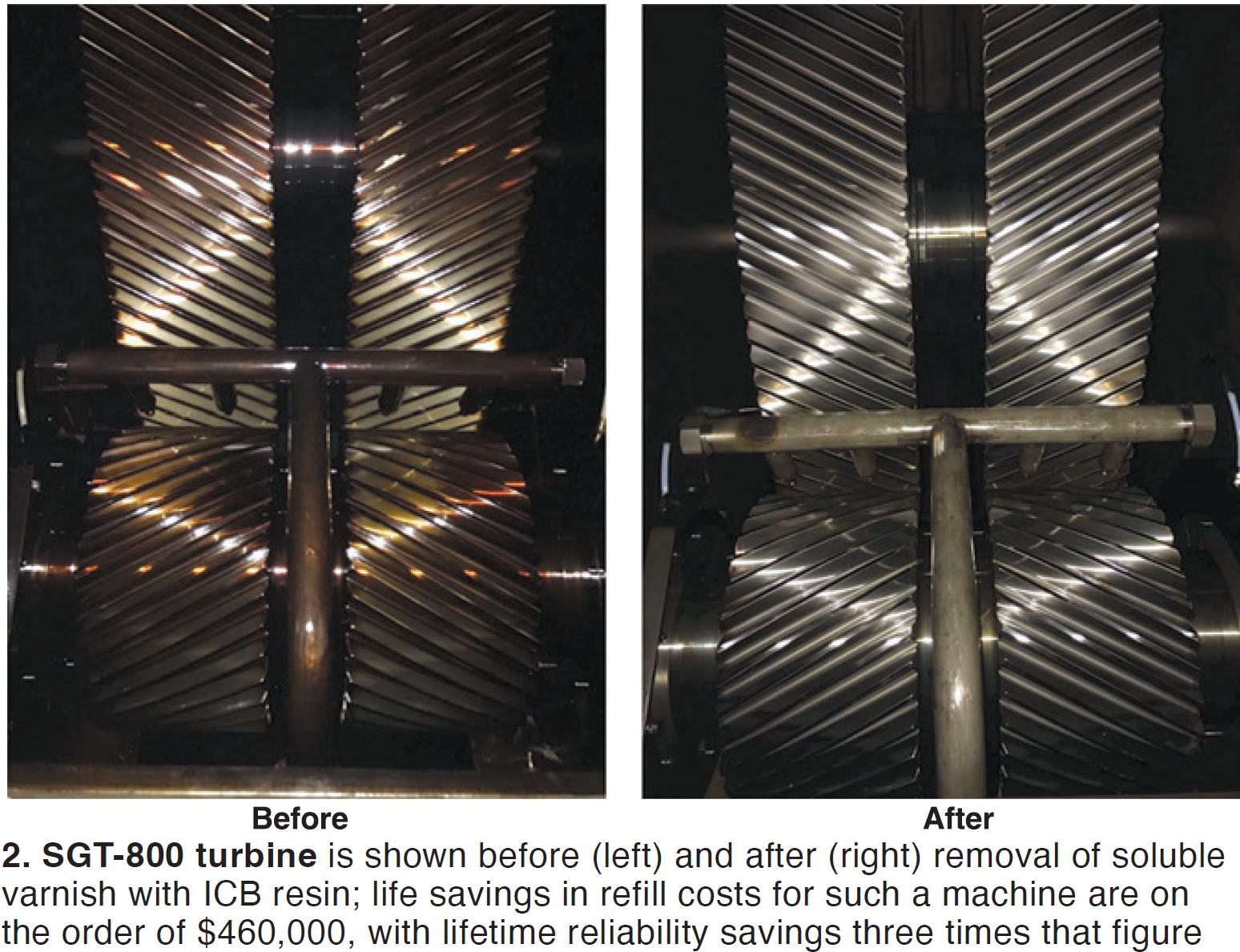
During the Q&A, Hobbs noted the following:
- He favors the rotating pressure vessel oxidation test (RPVOT, ASTM D2272) as a monitoring tool, but it does not substitute for the MPC test.
- Regeneration of resin is very energy intensive and generally not worth the time or money: Only about five to 13 lb of resin is used over the life of a machine.
- Design of the ICB ion exchange resin system, especially resin selection, must be tailored to the user’s needs and type of lubricant.
- One user Hobbs is familiar with had varnish issues in his machine even when the MPC level was as low as 9. Note that below 15 is considered “acceptable,” 15-35 elevated, and more than 35 critical.
View the presentation in its entirety below.
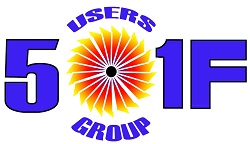
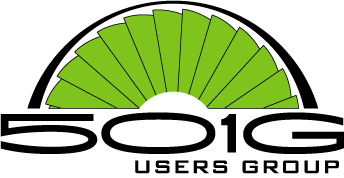
Owner/operators of Siemens Energy/Westinghouse Electric Corp 501F and 501G gas turbines co-locate at the Peppermill Resort and Spa in Reno, Nev, for their 2023 conferences, Sunday Feb 19 through noon Thursday Feb 23. The last time these two organizations shared the same in-person venue was in February 2020 at the Hilton West Palm Beach, about a month before the pandemic changed things.
Sunday’s program features social events for all attendees. The agenda for Monday—including a safety roundtable, vendor presentations, and vendor fair—also is for both the 501F and 501G Users Groups. The organizations meet independently on Tuesday, Wednesday, and Thursday for technical presentations by users, services providers, and OEMs.
CCJ’s special publication for the 501F/G event, sponsored by Arnold Group, begins with the Monday program—including the Vendorama schedule and Exhibit Hall floorplan, the latter with participants and booth numbers identified. Bear in mind that some of the information may have changed since it was provided to the editors on January 23 to meet the Journal’s printing schedule.
Conference sponsors
AGT Services
Badger Industries
Doosan Turbomachinery Services
EagleBurgmann
Falcon Crest Aviation Supply
Mitsubishi Power
Nord-Lock
PSM
Siemens Energy
Tetr Engineering Group
Trinity Turbine Technology
Sections specific to the F and G programs come next, along with summaries of presentations from previous meetings to bring attendees up to date on topics of importance they may have overlooked during the pandemic years.
- 501F Users Group program for 2023
- 501G Users Group program for 2023
- 501F 2022 conference recap: User sessions
- 501F 2022 conference recap: Vendor presentations
- Excerpts from recent 501G plant reports
- Abstracts of recent 501G user presentations
- Steve Bates, the long-time leader of the 501G Users Group, who died suddenly November 30 while on a family vacation, is remembered by colleagues here.
Monday agenda for all users
The meeting gets underway after breakfast at 8 a.m. with welcomes by the user-group chairs and introductions. Safety roundtable is next, focusing on human performance, led by a well-respected subject-matter expert. The Vendorama program gets underway at 10:20 following a tutorial on the 501F website and the morning break.
Note that all conference activities associated with the 501F and 501G Users Groups, including meals, are in the Tuscany Ballroom, which can be divided, as necessary, in up to a dozen individual rooms (Tuscany 1, 2, 3, etc). The room numbers for specific activities (such as those for the Vendorama presentations) are not identified here because they likely will change prior to the meeting. Current information is available in the conference registration area.
The 35 half-hour Vendorama presentations are arranged in seven sessions, with five presentations conducted in parallel during each session. Here are the topics and companies involved:
Session 1, 10:20, a.m. Contingency planning for steam-turbine outages, Advanced Turbine Support; Lube-oil maintenance, Hy-Pro Filtration; Enhanced SCR and CO system management to meet today’s operational challenges, Environex; Status of 501F manufacturing programs, Doosan Turbomachinery Services; Long-term wear and failure modes of torque converters in starting packages, Powerflow Engineering.
Session 2, 10:55. Bigger HRSGs and the new problems they create, HRST; Extended-lifecycle soft parts for Frame 501 expansion joints, EagleBurgmann; Product and services update, Mitsubishi Power; New ISO 29461-2 and gas-turbine air inlet filters, NRG Faist Corp; 501F four-way-joint solution, Nord-Lock.
Session 3, 11:30. Pulse versus non-pulse filters—when and how to choose, Braden Filtration; Aging generator lifecycle planning and issue update, National Electric Coil; Best practices for automated gas-manifold and generator purging, Environment One Corp; ASME B31.1 (Section VII) as it relates to high-energy and covered piping systems, Industrial Air Flow Dynamics; Advanced steam-turbine and HRSG warming for significant startup improvement, Arnold Group.
Session 4, 1 p.m. 501F upgrades for legacy units (Part 1), Frenzelit; An IoT approach to predictive maintenance, Camfil Power Systems; Product and services update, PSM; Product and services update, ORR Protection Systems; Top five most common issues affecting your SCR system, CECO Environmental/Peerless Mfg Co.
Session 5, 1:35. 501F upgrades for legacy units (Part 2), Frenzelit; Case studies on turbine-exhaust-system gas-path upgrades to improve safety, reliability, and performance, SVI Dynamics/Bremco; Are you abusing your generators? AGT Services; New ISO 29461-2 and gas-turbine air inlet filters, NRG Faist Corp; PAG-based EHC fluid—A sustainable alternative to phosphate ester for EHC application, Shell Oil Products.
Session 6, 2:30. Potential for hydrogen use in GT-CC duct burners under new USA H2 production tax, Tetra Engineering Group; New ISO test standard for gas-turbine inlet filtration, Camfil Power Systems; Gas-turbine expansion joints, Industrial Air Flow Dynamics; Product and services update, PSM.
Session 7, 3:05. Advanced NDT testing methods for decreasing operational risk, Veracity Technology Solutions; Product and services update, Sulzer; Wet compression for 501Fs, Mee Fog; Protection of gas turbines using high-pressure water mist, Marioff NA; Oil maintenance in powerplants—What about transformer oil? C C Jensen Oil Maintenance.
Monday evening exhibitors
| AAF International
Accumetrics Advanced Turbine Support AGT Services Inc Allied Power Group Alta Solutions Inc American Thermal Solutions Arnold Group Badger Industries BBM-CPG Technology Bearings Plus Braden Bruel & Kjaer Vibro C C Jensen Camfil Power Systems Catalytic Combustion Corp CECO Environmental/Peerless Mfg Conax Technologies Conval Inc Cutsforth Inc Doble Engineering Co Donaldson Company Doosan Turbomachinery Services Inc Durr Universal Inc EagleBurgmann Environex Inc Environment One Corp Faist Filters Falcon Crest Aviation Supply Inc Fisher Improvement Technologies Frenzelit Inc Freudenberg Filtration Groome Industrial Hilco Filtration Systems HRST Inc Hy-Pro Filtration |
Industrial Air Flow Dynamics Inc
Iris Power-Qualitrol Kingsbury Inc Koenig Engineering Inc Liburdi Turbine Services Inc LPG Industries Inc Macemore Inc Marioff NA Mee Industries Inc Millennium Power Services Mitsubishi Power Moog Munters Corp National Electric Coil Nederman Pneumafil Nord-Lock Inc ORR Protection Parker Hannifin Corp Powerflow Engineering Inc PSM Rochem Technical Services ROMCO Manufacturing Inc Schock Manufacturing Shell Oil Products Siemens Energy Sulzer Turbo Services Houston Inc SVI Industrial (SVI Dynamics/Bremco) Tetra Engineering Group Inc TOPS Trinity Turbine Technology LP TRS Services LLC Vector Systems, Inc Veracity Technology Solutions Viking Turbine Services Inc Voith US |



